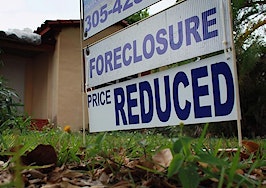What started out as a rather staid academic exercise ended up turning heads across the real estate industry with its rather bold conclusion.
We could be in the early stages of fueling a new housing bubble, a team of researchers working with the Federal Reserve Bank of Dallas proposed a little over a month ago.
According to their telling, ballooning home price growth may have been spurred, in part, by a shared belief among buyers that prices would only continue to go up, regardless of the rental income those properties could produce, or other key economic indicators.
Since late March, many in the real estate industry have discussed the report, but not everyone is buying it.
Jeff Tucker, a senior economist for Zillow, is one of the skeptics. The market is reaching an inflection point as dynamics start to shift away from heavily-favored sellers, he wrote last week.
But Tucker doesn’t expect that shift to result in widespread home-price reductions. For one thing, demand for homes is likely to be more resilient than the Fed researchers accounted for, he argued.
“If prices did begin to fall, we know there are millions of stymied first-time buyers, or younger millennials soon to be aging into that situation, waiting in the wings to snap up homes if they see a bargain,” Tucker wrote.
Instead, Tucker worries that talk of a “bubble” could actually hurt future buyers, who need homebuilders to continue producing new inventory.
Builders are juggling more active projects than they have since before the Great Recession. This means they would be at risk of losing a lot of money if there were a potential downturn in prices, Tucker said in the report.
“If they trim their construction plans out of caution, we will miss out on one of the best hopes we have for net new inventory on the market, and the inventory crunch that’s helped push prices up will persist for longer than expected,” Tucker said.
Another consideration: Since the period that the Fed researchers studied, rent growth has accelerated throughout much of the country.
Rents are now up 17 percent over the past year, Tucker said. And with consumers facing their highest price inflation in four decades, more Americans are likely to turn to real estate as a way of protecting their savings, he added.
Looking ahead, Tucker thinks a turnaround in America’s slimmed-out home inventory could be well underway.
Throughout every month of the pandemic, the number of active homes for sale has been lower than it was at the same time the year before. But based on recent months’ activity, Tucker thinks the market could be poised to see year-over-year inventory growth before the end of 2022.
This would be a sign of better conditions for buyers, since improved inventory can be a barometer of a waning advantage that sellers have over their eager counterparts, he said.
“More inventory is both the consequence and the cause of a more balanced housing market,” Tucker wrote. “It gives home shoppers more options to choose from — limiting the number of buyers bidding on each home — and lights a competitive fire under sellers and their listing agents to make their homes shine, and to be wary of overpricing.”
Still, the full recovery to pre-pandemic conditions is expected to take years, not months.
If inventory continues to recover as quickly as it did in March, it would still take until September, 2024, to reach the levels observed in 2019, Tucker said.
The Fed researchers were careful to mention in their report, that they didn’t think a bubble would bring about the same devastating effects on the global financial system as we saw in 2007.
Today’s buyers remain in better financial shape, and are less reliant on debt for their home purchases. Policymakers can also use the last crisis as a guide for acting early, preventing the worst potential outcomes of a future drop in home prices.
But there’s no doubt that newly purchased homes have been growing less affordable by the day. Mortgage rates are up, and home prices are continuing to rise alongside them at a speed with which wage growth hasn’t kept pace.
Fortunately for current homeowners, most of them are protected from the effects of future rate increases, Tucker said.
“Most existing homeowners are insulated from high mortgage rates, thanks to more than 90 percent of loans in the past several years being vanilla fixed-rate, fully amortizing mortgages,” Tucker wrote. “That keeps people’s current bills affordable, and will prevent a foreclosure wave like the one that helped cause the housing market to spin out of control and crash in 2008.”













